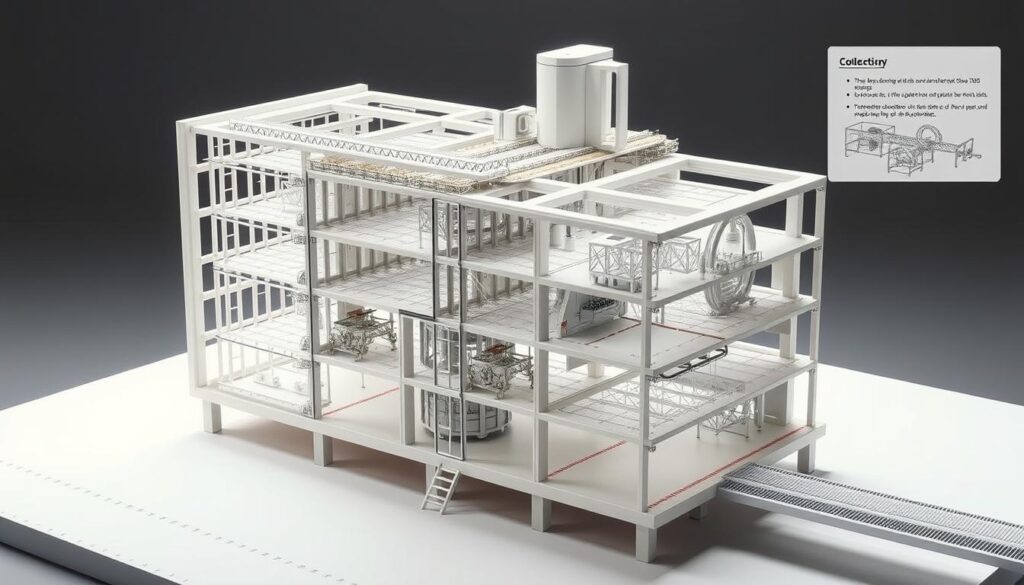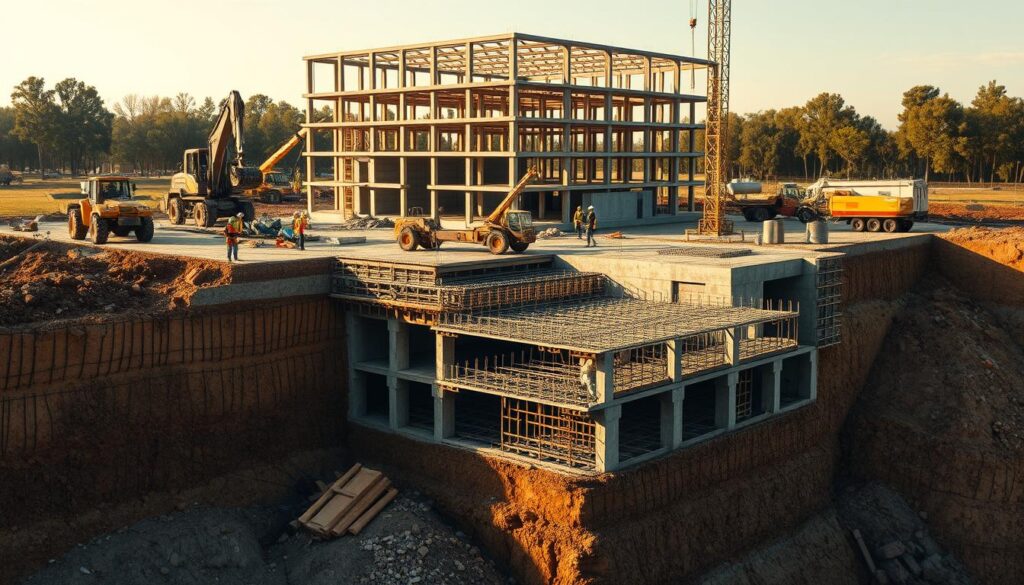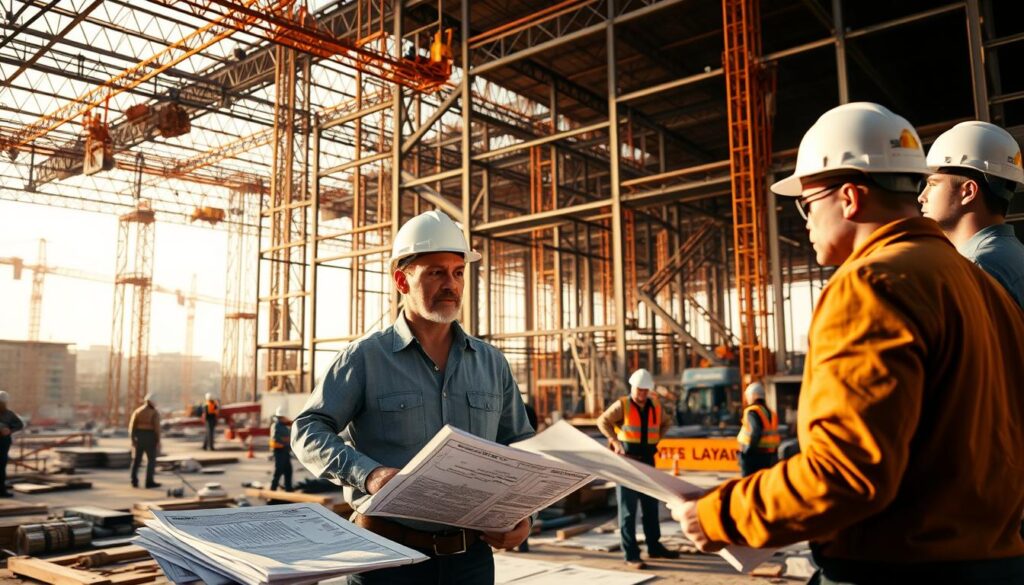The built environment is a testament to the power of structural engineering. From towering skyscrapers to sturdy bridges, the work of structural engineers is evident in the stability and safety of the structures we use daily.
Civil engineering plays a vital role in shaping our surroundings, ensuring that buildings and bridges can withstand various forces. The importance of building design and structural analysis cannot be overstated, as they are crucial to the safety and durability of our infrastructure.
Key Takeaways
- The role of structural engineers in ensuring the stability and safety of buildings and bridges.
- The importance of building design and structural analysis in construction engineering.
- The impact of civil engineering on the built environment.
- The significance of structural engineering in designing safe and sturdy structures.
- The application of construction engineering principles in modern building practices.
What Is Structural Engineering?
Structural engineering is a specialized branch of civil engineering that focuses on the analysis, design, and construction of load-bearing structures. It is a critical discipline that has shaped the modern built environment, enabling the creation of safe, functional, and aesthetically pleasing buildings and infrastructure.
Definition and Core Principles
The core principles of structural engineering revolve around ensuring the structural integrity of buildings and other structures. This involves understanding the behavior of various materials and systems under different loads and conditions. Structural engineers must consider factors such as strength, stability, and durability when designing structures.
The definition of structural engineering encompasses several key elements, including:
- Analysis of structural behavior under various loads
- Design of structural systems and components
- Selection of appropriate materials and construction techniques
- Ensuring compliance with relevant building codes and standards
The Evolution of Structural Engineering Through History
Structural engineering has a rich history that spans thousands of years, from ancient civilizations to modern times. The field has evolved significantly over the centuries, driven by advances in materials science, construction techniques, and our understanding of physics and mathematics.
| Era | Notable Achievements |
|---|---|
| Ancient Civilizations | Development of basic structural systems, such as post-and-beam construction |
| Middle Ages | Advances in masonry construction, including the development of Gothic architecture |
| Industrial Revolution | Introduction of new materials like iron and steel, enabling larger and more complex structures |
| 20th Century | Advances in concrete technology, development of modern structural analysis techniques |
How Structural Engineers Shape Our Built Environment
Structural engineers play a crucial role in shaping the built environment, from designing iconic landmarks to creating functional and efficient buildings. Their work involves collaboration with architects, contractors, and other stakeholders to bring projects to life.
By combining technical expertise with creativity and problem-solving skills, structural engineers contribute to the development of innovative and sustainable structures that meet the needs of communities and societies.
The Science Behind Structural Analysis
Understanding the science behind structural analysis is essential for designing safe and efficient structures. Structural analysis involves determining the forces acting on each structural element, while design involves configuring these elements to resist known forces. This intricate process requires a deep understanding of the principles of structural mechanics and the various forces that structures are subjected to.

Understanding Forces and Loads
Structures are subjected to various types of forces and loads, including dead loads, live loads, wind loads, and seismic loads. Dead loads are the permanent weights of the structure itself, while live loads are temporary and can vary, such as people, furniture, and vehicles. Wind and seismic loads are dynamic forces that can significantly impact a structure’s stability. Understanding these forces is crucial for designing structures that can withstand various loading conditions.
The distribution of these forces throughout a structure is also critical. For instance, load-bearing walls and columns play a vital role in transferring loads to the foundation. Structural engineers must carefully analyze how these forces interact with the structure to ensure its stability and integrity.
Principles of Structural Mechanics
The principles of structural mechanics provide the theoretical foundation for structural analysis. These principles include the concepts of equilibrium, compatibility, and constitutive relationships. Equilibrium ensures that the forces acting on a structure are balanced, while compatibility guarantees that the structure’s deformations are consistent with its constraints. Constitutive relationships describe how materials respond to different loading conditions.
By applying these principles, structural engineers can analyze complex structures and predict their behavior under various loading scenarios. This knowledge enables the design of structures that are not only safe but also efficient and resilient.
Types of Structures in Modern Construction
Modern construction involves the creation of diverse structures, each presenting unique challenges and opportunities for structural engineers. These structures are fundamental to our built environment, serving various purposes and requiring specialized design and construction techniques.
Residential Buildings
Residential buildings are a primary focus for structural engineers, encompassing single-family homes, apartment complexes, and condominiums. These structures must be designed to provide safe and comfortable living spaces while adhering to local building codes and regulations. Structural design services play a crucial role in ensuring that residential buildings can withstand various loads and environmental conditions.
Commercial and Industrial Facilities
Commercial and industrial facilities, including office buildings, factories, and warehouses, present distinct structural challenges. These buildings often require large open spaces, heavy load-bearing capacities, and specialized structural systems. Structural engineers must consider factors such as equipment loads, material handling systems, and future expansion possibilities when designing these facilities.
Infrastructure Projects
Infrastructure projects, such as bridges, tunnels, and highways, are critical components of modern transportation systems. Bridge engineering, for instance, involves designing structures that can safely span distances while resisting natural forces like wind and earthquakes. Structural engineers working on infrastructure projects must collaborate closely with other professionals to ensure that these projects meet stringent safety and performance standards.
Iconic and Special-Purpose Structures
Iconic and special-purpose structures, including stadiums, museums, and monuments, often push the boundaries of structural engineering. These projects require innovative design solutions, advanced materials, and a deep understanding of the structure’s aesthetic and functional requirements. Structural engineers working on such projects must balance creativity with technical feasibility and safety considerations.
By understanding the diverse types of structures in modern construction, we can appreciate the complexity and importance of structural engineering in shaping our built environment.
Building Materials: The Backbone of Structural Engineering
Building materials form the backbone of structural engineering, with various options available to suit different construction needs. The choice of materials is crucial in determining the strength, durability, and sustainability of structures.
Concrete and Reinforced Concrete Systems
Concrete is one of the most widely used building materials due to its high compressive strength and versatility. Reinforced concrete, which combines concrete with steel reinforcement, offers enhanced tensile strength and is commonly used in building foundations, columns, and beams.
The use of concrete and reinforced concrete systems provides several benefits, including:
- High compressive strength
- Durability
- Fire resistance
- Low maintenance
| Property | Concrete | Reinforced Concrete |
|---|---|---|
| Compressive Strength | High | High |
| Tensile Strength | Low | High |
| Durability | High | High |
Structural Steel Applications
Structural steel is another popular building material, prized for its high strength-to-weight ratio, ductility, and flexibility. Steel is often used in the construction of high-rise buildings, long-span structures, and complex frameworks.
Advantages of structural steel include:
- High strength-to-weight ratio
- Ductility and flexibility
- Speed of construction
- Design flexibility

Timber and Engineered Wood Products
Timber and engineered wood products are gaining popularity due to their sustainability, aesthetic appeal, and structural performance. Engineered wood products, such as glued-laminated timber and cross-laminated timber, offer improved strength and stability compared to traditional timber.
Benefits of timber and engineered wood products include:
- Sustainability
- Aesthetic appeal
- Good structural performance
- Carbon sequestration
Innovative and Composite Materials
The construction industry is witnessing the emergence of innovative and composite materials, designed to enhance structural performance, sustainability, and durability. Examples include fiber-reinforced polymers, advanced concrete mixes, and hybrid materials combining different material properties.
Innovative materials offer potential benefits such as:
- Enhanced structural performance
- Improved sustainability
- Increased durability
- New design possibilities
The Structural Design Process from Concept to Completion
From initial concept to final completion, the structural design process involves meticulous planning and precise execution. Structural engineers play a vital role in this process, ensuring that the final product is not only safe and functional but also meets the client’s requirements.
Conceptual Design and Planning
The journey begins with conceptual design and planning, where the project’s objectives, constraints, and requirements are defined. During this phase, structural engineers collaborate with architects and other stakeholders to develop initial design concepts that balance aesthetics with structural integrity.
Preliminary Analysis and Design Development
Following the conceptual phase, preliminary analysis and design development take place. Here, engineers conduct initial structural analyses to assess the feasibility of the design concepts. This stage involves evaluating various structural systems and materials to determine the most appropriate solution for the project.
Detailed Design and Documentation
The detailed design and documentation phase is where the selected design concept is developed in-depth. Structural engineers create comprehensive drawings and specifications that outline every aspect of the structure, from the foundation to the roof. This documentation serves as the blueprint for the construction team.
Construction Support and Field Verification
Finally, construction support and field verification ensure that the structure is built according to the design specifications. Structural engineers provide on-site support, addressing any unforeseen issues that may arise during construction and verifying that the final product meets the design intent.
Throughout these stages, the structural design process demands a blend of creativity, technical expertise, and attention to detail. By following this systematic approach, structural engineers can deliver structures that are not only safe and durable but also meet the needs of their users.
Foundation Engineering: Creating Stable Building Bases
A stable foundation is the backbone of any structure, and foundation engineering plays a crucial role in ensuring this stability. It involves a comprehensive understanding of the soil, the structure’s design, and the environmental conditions that may impact the building’s integrity.
Geotechnical Investigation and Soil Analysis
Before designing a foundation, it’s essential to conduct a thorough geotechnical investigation. This process involves analyzing the soil composition, its density, and other properties that can affect the foundation’s stability. Soil analysis helps engineers understand the soil’s behavior under different conditions, enabling them to design a foundation that can withstand various loads and stresses.
| Soil Type | Characteristics | Foundation Design Considerations |
|---|---|---|
| Clay | High plasticity, prone to settlement issues | Deep foundations, soil stabilization techniques |
| Sand | Good drainage, potential for erosion | Shallow foundations, erosion protection measures |
| Rock | High bearing capacity, potential for difficult excavation | Shallow foundations, specialized excavation techniques |
Types of Foundation Systems
The choice of foundation system depends on the structure’s design, the soil conditions, and environmental factors. Common types include:
- Shallow foundations (spread footings, slab-on-grade)
- Deep foundations (piles, caissons)
- Specialized foundations (raft foundations, compensated foundations)
Each type has its advantages and is suited to specific conditions. For instance, shallow foundations are ideal for stable soil conditions, while deep foundations are necessary for soft or weak soils.

Special Considerations for Challenging Sites
Some sites present unique challenges due to difficult soil conditions, environmental factors, or other site-specific issues. Foundation engineers must adapt their designs to address these challenges, ensuring the structure’s stability and safety.
Examples of challenging sites include:
- Sites with expansive soils that can cause foundation damage due to swelling or shrinking
- Areas with high water tables or prone to flooding, requiring specialized drainage solutions
- Locations with seismic activity, necessitating earthquake-resistant foundation designs
By understanding these challenges and applying appropriate foundation engineering techniques, engineers can create stable building bases even in the most difficult conditions.
Designing for Natural Disasters and Extreme Events
Designing structures to withstand natural disasters is a critical aspect of modern engineering. Structural engineers play a crucial role in creating buildings and infrastructure that can resist extreme events such as earthquakes, hurricanes, floods, and fires. The importance of disaster-resistant design cannot be overstated, as the consequences of failure can be catastrophic.
Earthquake-Resistant Design Strategies
Earthquake-resistant design involves creating structures that can absorb and dissipate seismic energy. Key strategies include:
- Using ductile materials that can deform without failing
- Designing buildings with a robust lateral load-resisting system
- Instituting regular inspection and maintenance protocols
According to the International Building Code (IBC), buildings in seismic zones must be designed to withstand earthquakes without collapsing, ensuring the safety of occupants.
Hurricane and High Wind Design
Hurricane-resistant design focuses on creating structures that can withstand high winds and flying debris. Strategies include:
- Using wind-resistant roofing materials and designs
- Reinforcing building envelopes to prevent water intrusion
- Designing windows and doors to resist wind-borne debris
A notable example is the Miami-Dade County building codes, which have been updated to include stringent wind-resistance standards following hurricane events.
Flood-Resistant Construction
Flood-resistant construction involves elevating structures, using flood-resistant materials, and designing buildings to minimize damage from floodwaters. Techniques include:
- Elevating electrical and mechanical systems above expected flood levels
- Using water-resistant materials for building envelopes
- Designing drainage systems to quickly dissipate floodwaters
“Flood-resistant design is not just about keeping water out; it’s about minimizing damage when water does enter.” –
Fire Protection Engineering
Fire protection engineering encompasses designing structures to resist fire spread and ensuring occupant safety during fires. Strategies include:
| Strategy | Description |
|---|---|
| Compartmentalization | Dividing buildings into fire-resistant compartments |
| Fire-Resistant Materials | Using materials that resist ignition and fire spread |
| Active Fire Suppression | Installing systems like sprinklers to suppress fires |
In conclusion, designing for natural disasters and extreme events requires a multifaceted approach, incorporating strategies for earthquake resistance, hurricane and high wind resistance, flood resistance, and fire protection. By understanding and implementing these strategies, structural engineers can significantly enhance the resilience of structures, protecting both people and property.
Building Codes and Standards in the United States
The framework of building codes and standards in the U.S. is designed to protect public health and safety by regulating building practices. These codes and standards are crucial for ensuring that structures are designed and constructed to withstand various environmental and operational stresses.
International Building Code (IBC) and ASCE Standards
The International Building Code (IBC) is a model code that has been adopted by most jurisdictions across the United States. It provides comprehensive regulations for the design, construction, and occupancy of buildings. The IBC references various standards, including those from the American Society of Civil Engineers (ASCE), to ensure that structures are built to withstand natural disasters and other external forces.
ASCE standards are particularly important for structural engineers, as they provide detailed guidelines for designing structures that can resist earthquakes, high winds, and other hazards. For instance, ASCE 7-16, “Minimum Design Loads and Associated Criteria for Buildings and Other Structures,” is a critical standard that outlines the minimum design loads for buildings.

State and Local Code Adaptations
While the IBC serves as a baseline, state and local governments often adapt and modify it to suit their specific needs. These adaptations can include more stringent requirements for earthquake resistance in seismic zones or higher wind loads in hurricane-prone areas. Structural engineers must be aware of these local adaptations to ensure code compliance.
The Permitting Process for Structural Projects
Before construction can begin, structural projects must go through a permitting process. This involves submitting detailed plans and specifications to the relevant authorities for review. The review process ensures that the project complies with all applicable building codes and standards. Quality assurance is a critical aspect of this process, as it helps to identify and rectify any potential issues before they become major problems.
Code Compliance and Quality Assurance
Achieving code compliance is not just about meeting the minimum requirements; it’s about ensuring that the structure is safe and durable. Structural engineers play a key role in this process by designing structures that meet or exceed code requirements. Regular inspections and testing during construction are also essential for maintaining quality assurance.
In conclusion, building codes and standards are fundamental to the practice of structural engineering in the United States. By understanding and adhering to these codes and standards, structural engineers can ensure that their designs are safe, durable, and compliant with regulatory requirements.
Digital Tools Revolutionizing Structural Engineering
Digital tools are revolutionizing the field of structural engineering, enhancing efficiency and accuracy in design and analysis. The integration of advanced software and technologies has transformed the way structural engineers work, enabling them to tackle complex projects with greater precision and confidence.
Computer-Aided Design (CAD) and Drafting
Computer-Aided Design (CAD) has become an indispensable tool in structural engineering, allowing engineers to create detailed designs and drafting with precision. CAD software enables the creation of complex geometric models, facilitating the analysis and simulation of structural behavior under various loads.
- Automated drafting reduces errors and improves productivity
- Advanced CAD tools enable the creation of complex designs
- Integration with other software enhances collaboration and data exchange
Building Information Modeling (BIM) Integration
Building Information Modeling (BIM) takes CAD a step further by incorporating additional data and information into the design process. BIM integration enables a more comprehensive understanding of the building’s lifecycle, from design to construction and operation.
The benefits of BIM integration include:
- Enhanced collaboration among stakeholders
- Improved data consistency and reduced errors
- Better visualization and simulation capabilities
Finite Element Analysis (FEA) Software
Finite Element Analysis (FEA) is a computational method used to simulate the behavior of complex structures under various loads. FEA software enables structural engineers to analyze the stress, strain, and deformation of structures, allowing for more accurate and reliable designs.
The advantages of FEA software include:
- Detailed analysis of structural behavior
- Simulation of various load scenarios and conditions
- Optimization of structural designs for performance and safety
Emerging Technologies
The field of structural engineering is continually evolving, with emerging technologies such as artificial intelligence, machine learning, and cloud computing beginning to make an impact. These technologies have the potential to further transform the practice of structural engineering, enabling new levels of efficiency, accuracy, and innovation.
Some of the emerging trends and technologies include:
- Integration of AI and machine learning in design and analysis
- Cloud-based collaboration and data management
- Advanced materials and construction techniques
Structural Assessment and Rehabilitation
Ensuring the longevity of structures necessitates comprehensive assessment and rehabilitation efforts. As our built environment continues to age, the need for thorough evaluations and targeted interventions becomes increasingly important. This process not only enhances the safety and functionality of existing buildings but also plays a crucial role in preserving our architectural heritage.
Inspection Methods and Techniques
Effective structural assessment begins with rigorous inspection methods. Visual inspections are often the first step, allowing engineers to identify potential issues and determine the need for more detailed evaluations. Advanced techniques, such as nondestructive testing (NDT), enable the assessment of a structure’s condition without causing damage. These methods can include:
- Ultrasonic testing
- Radiographic inspection
- Acoustic emission testing
- Magnetic particle testing
By employing these techniques, engineers can gather critical data on a structure’s integrity, informing rehabilitation strategies and ensuring that interventions are both necessary and effective.

Evaluating Existing Structures
Evaluating existing structures involves a comprehensive analysis of their condition, considering factors such as:
| Evaluation Criteria | Description |
|---|---|
| Structural Integrity | Assessment of load-bearing elements and overall stability |
| Material Condition | Evaluation of deterioration, damage, or degradation |
| Functional Performance | Analysis of the structure’s ability to meet its intended purpose |
This evaluation process informs the development of targeted rehabilitation plans, addressing specific needs and enhancing the structure’s overall performance.
Retrofitting and Strengthening Solutions
Retrofitting and strengthening are critical components of structural rehabilitation. Engineers employ various techniques to enhance a structure’s resilience, including:
- Seismic retrofitting to improve earthquake resistance
- Adding structural elements to enhance load-bearing capacity
- Upgrading connections and joints for improved stability
- Implementing advanced materials and technologies
These interventions not only improve a structure’s safety but also extend its service life, preserving its functionality for future generations.
Historic Structure Preservation
Preserving historic structures presents unique challenges, requiring a delicate balance between maintaining original character and ensuring modern safety standards. Historic preservation efforts involve:
- Documenting and analyzing the structure’s historical significance
- Employing traditional craftsmanship and materials where appropriate
- Implementing subtle interventions to minimize visual impact
- Ensuring compliance with contemporary building codes and regulations
By adopting a sensitive and informed approach, preservationists can safeguard the integrity of historic structures while respecting their cultural and architectural value.
Sustainable Structural Engineering Practices
As the world shifts towards more environmentally conscious practices, sustainable structural engineering is taking center stage. This shift is driven by the need to reduce the environmental impact of construction projects while maintaining structural integrity and efficiency.
Integrating Green Building Principles
Integrating green building principles into structural engineering involves adopting design and construction methods that minimize environmental footprint. This includes using energy-efficient systems, reducing waste, and optimizing the use of natural resources.
- Implementing energy-efficient design elements
- Utilizing renewable energy sources
- Minimizing water consumption through efficient systems
- Reducing, reusing, and recycling construction materials
Material Selection for Environmental Performance
The selection of materials plays a crucial role in sustainable structural engineering. Materials with low embodied energy, high recyclability, and sustainably sourced products are preferred.
Key considerations for material selection include:
- Embodied energy of materials
- Recyclability and reusability
- Sustainable sourcing and production methods
- Durability and longevity
Optimizing Structural Systems for Efficiency
Optimizing structural systems for efficiency involves designing structures that minimize material usage while maintaining or enhancing structural performance. This can be achieved through advanced analysis techniques and innovative design solutions.
- Utilizing advanced structural analysis software
- Implementing innovative structural systems
- Minimizing material waste through efficient design
- Enhancing structural performance through material optimization
LEED and Other Sustainability Certifications
Sustainability certifications like LEED (Leadership in Energy and Environmental Design) play a significant role in promoting sustainable structural engineering practices. These certifications provide a framework for evaluating and recognizing sustainable design and construction practices.
Benefits of LEED certification include:
- Enhanced marketability of sustainable projects
- Recognition of environmental stewardship
- Potential for energy and resource savings
- Increased property value
Project Management in Structural Engineering
Effective project management is the backbone of successful structural engineering projects. It encompasses a broad range of activities, including planning, budgeting, risk assessment, and quality assurance. Structural engineers must navigate complex projects, ensuring that they are completed on time, within budget, and to the required quality standards.
Planning and Scheduling Complex Projects
Planning and scheduling are critical components of project management in structural engineering. This involves creating detailed project timelines, identifying key milestones, and allocating resources effectively. Structural engineers must work closely with contractors, architects, and other stakeholders to ensure that projects are delivered on schedule.
A well-planned project schedule helps to mitigate potential delays and ensures that all parties are aware of their responsibilities and deadlines. Utilizing tools like Gantt charts and project management software can significantly enhance the planning process.
| Project Phase | Key Activities | Responsible Parties |
|---|---|---|
| Design | Conceptual design, detailed design | Structural Engineers, Architects |
| Procurement | Material sourcing, contractor selection | Project Managers, Procurement Teams |
| Construction | Site preparation, building construction | Contractors, Site Managers |
Budget Management and Cost Control
Budget management is another vital aspect of project management in structural engineering. This involves establishing a realistic budget, tracking expenses, and identifying areas for cost savings. Structural engineers must balance the need for quality and safety with the requirement to stay within budget.
Effective cost control measures include regular financial reporting, cost forecasting, and value engineering. By optimizing the design and construction processes, structural engineers can help minimize unnecessary expenditures and ensure that projects remain financially viable.

Risk Assessment and Mititation
Risk assessment and mitigation are essential components of project management in structural engineering. This involves identifying potential risks, assessing their likelihood and impact, and developing strategies to mitigate or manage them.
- Identifying potential risks such as design errors, material failures, or construction delays
- Assessing the likelihood and potential impact of these risks
- Developing mitigation strategies, such as contingency planning or risk transfer
Quality Assurance Procedures
Quality assurance is a critical aspect of project management in structural engineering, ensuring that projects meet the required standards and specifications. This involves implementing quality control measures, conducting regular inspections, and addressing any defects or non-conformities.
Effective quality assurance procedures include:
- Establishing clear quality standards and specifications
- Implementing quality control processes and checks
- Conducting regular inspections and audits
- Addressing any defects or non-conformities promptly
The Collaborative Nature of Structural Engineering
The field of structural engineering is inherently collaborative, requiring seamless interaction among architects, engineers, clients, and construction teams. This collaborative environment ensures that projects are executed efficiently, safely, and to the satisfaction of all parties involved.
Working with Architects and Design Teams
Structural engineers work closely with architects to ensure that the structural system aligns with the architectural vision. This collaboration is crucial in creating buildings that are not only aesthetically pleasing but also structurally sound. By integrating their expertise, architects and structural engineers can develop innovative solutions that enhance the overall design.
For instance, the use of Building Information Modeling (BIM) technology facilitates this collaboration by creating a shared digital model that both architects and engineers can access and modify. This ensures that any changes are reflected in real-time, reducing the likelihood of errors and miscommunications.
Coordination with Other Engineering Disciplines
Structural engineers must also coordinate with other engineering disciplines, such as mechanical, electrical, and plumbing engineers. This interdisciplinary coordination is vital to ensure that all systems within a building are compatible and function cohesively.
A notable example of successful interdisciplinary coordination is the Sydney Opera House, where structural engineers worked alongside other experts to create an iconic structure with complex geometrical requirements.
| Engineering Discipline | Role in Project | Collaboration Benefits |
|---|---|---|
| Structural Engineering | Designing the structural system | Ensures stability and safety |
| Mechanical Engineering | Designing HVAC and mechanical systems | Enhances building performance and efficiency |
| Electrical Engineering | Designing electrical systems | Ensures reliable power distribution and lighting |
Client Communication and Stakeholder Management
Effective client communication is critical in structural engineering. Engineers must understand client needs, provide regular updates, and address any concerns promptly. This helps build trust and ensures that the final product meets client expectations.
Stakeholder management involves identifying and engaging with all parties who have a vested interest in the project. This includes not only clients but also contractors, regulatory bodies, and the local community.
- Regular project meetings
- Clear and concise reporting
- Proactive issue resolution
Construction Team Collaboration
Collaboration with the construction team is essential to ensure that the design is executed correctly. Structural engineers work closely with contractors to provide construction support, address any site-specific issues, and verify that the construction aligns with the design intent.
This collaboration helps to prevent costly rework, reduces the risk of delays, and ensures that the project is completed to the required quality standards.
Career Opportunities in Structural Engineering
A career in structural engineering offers a wide range of opportunities for professionals who are passionate about designing and developing safe, sustainable, and innovative structures. The field is dynamic, combining principles from physics, mathematics, and materials science to create buildings, bridges, and other infrastructure that can withstand various environmental conditions.
Education and Professional Licensing Requirements
To become a structural engineer, one typically needs to earn a bachelor’s degree in civil engineering, structural engineering, or a related field. Many professionals in this field also hold advanced degrees. Professional licensing is another critical aspect, with most states requiring structural engineers to be licensed as Professional Engineers (PEs). This typically involves passing the Fundamentals of Engineering (FE) exam and gaining relevant work experience before taking the Principles and Practice of Engineering (PE) exam.
Specialization Paths Within the Field
Structural engineers can specialize in various areas, including:
- Seismic design and retrofitting
- High-rise building design
- Bridge engineering
- Forensic structural engineering
- Sustainable design and green building
These specializations allow engineers to develop deep expertise and contribute to cutting-edge projects.

Professional Organizations and Continuing Education
Professional organizations like the American Society of Civil Engineers (ASCE) and the Structural Engineering Institute (SEI) play a crucial role in providing continuing education opportunities, networking, and advocating for the profession. These organizations help structural engineers stay updated on the latest technologies, codes, and best practices.
Job Outlook and Industry Trends
The job outlook for structural engineers is generally positive, driven by the need for infrastructure development, urbanization, and the retrofitting of existing structures to meet modern safety and sustainability standards. Industry trends include the increasing use of Building Information Modeling (BIM), advanced materials, and performance-based design methods. As infrastructure needs evolve, the demand for skilled structural engineers is expected to continue growing.
In conclusion, a career in structural engineering offers numerous opportunities for professional growth and the chance to contribute to significant infrastructure projects. By staying informed about industry trends and continually developing their skills, structural engineers can thrive in this dynamic field.
Conclusion: The Future of Structural Engineering
The field of structural engineering is on the cusp of a new era, driven by emerging trends, innovative materials, and a growing emphasis on sustainable practices. As the industry continues to evolve, structural engineering firms are at the forefront, leveraging cutting-edge technologies and methodologies to shape the built environment.
The future of structural engineering will be characterized by increased adoption of digital tools, such as Building Information Modeling (BIM) and Finite Element Analysis (FEA), enhancing the design and analysis process. Innovative materials, including advanced composites and high-performance concrete, will play a crucial role in creating more resilient and efficient structures.
Sustainable practices will remain a key focus, with structural engineers optimizing designs to minimize environmental impact while maximizing performance. As the industry moves forward, collaboration between stakeholders, including architects, contractors, and clients, will be essential in driving progress and achieving shared goals.
By embracing these emerging trends and technologies, structural engineering firms will continue to push the boundaries of what is possible, creating a built environment that is safer, more sustainable, and more resilient for generations to come.

Pingback: Designing Earthquake-Resistant Structures: Key Considerations